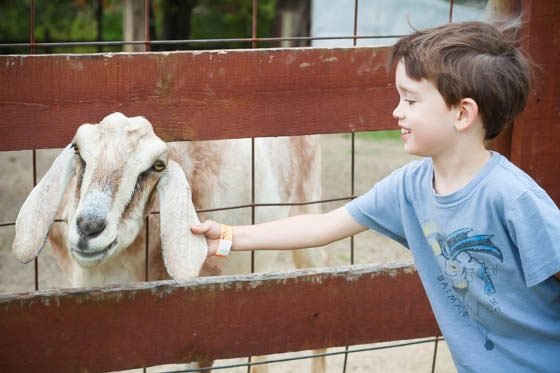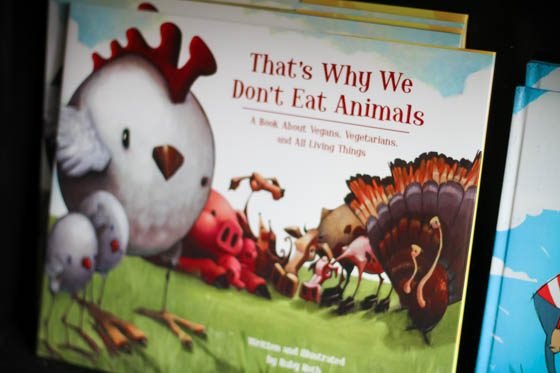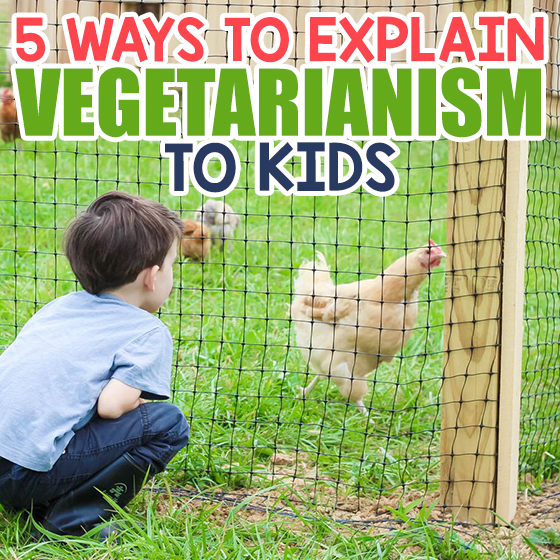The decision to raise vegetarian kids is one parents generally make for a variety of reasons. In addition to animal rights, environmental concerns and ethical issues, there are also a myriad of personal and hard-to-articulate reasons parents decide to raise their kids vegetarian.
No matter your motivation, it’s important to give kids a full explanation of the issue — in as unbiased and compassionate way possible. Everyone is entitled to their own choices, and you need to make sure you’re explaining vegetarianism to your kids in a way that’s respectful of others!
When explaining ideas to kids, it’s sometimes easier to show them rather than tell them. Here are 5 interactive ways to explain vegetarianism to your kids.
If You’re Veg for the Earth: Visit a Farm

If you decided to stop eating meat once you heard that the combined climate change emissions of animals bred for their meat were about 18% of the global total — more than cars, planes and all other forms of transportation put together, you might be a vegetarian for environmental reasons. You might also drive a Prius, own separate recycling bins, and compost!
If you’re vegetarian for environmental reasons, try taking your kids to a real, working farm. Even better — volunteer at a farm. Have your kids get up close and personal with the earth, and see everything that goes into growing, farming and harvesting crops. Share with them facts about livestock farming: did you know that nearly 30% of the available ice-free surface area of the planet is now used by livestock, or for growing food for those animals? Let kids get a sense of the labor and resources involved in farming — by farming themselves. They’ll gain a respect for the earth and a greater understanding of the complex environmental issues involved in meat production.
If You’re Veg for the Animals: Volunteer

If you regularly donate to PETA, volunteer at the humane society, or own a rescue pup or two, you probably went vegetarian for animal rights issues.
The best way to explain “animal rights” to kids is to get down and dirty with animals. Volunteer at an animal sanctuary, rescue organization or farm. Let them pet and play with the goats, feed the chickens and talk to the cows. Make farm animals a part of your regular life — not some intangible idea from songs, books and movies.
If You’re Veg for Your Health: Cook!

Maybe your vegetarian journey started when you eliminated red meat after reading it wasn’t the healthiest. Then, you slowly cut out chicken, then fish… and there you were: a vegetarian! Maybe you never really liked meat at all. Perhaps you’re a so-called “locavore” who likes eating close to the source and prefers vegetarian cuisine.
If you’re a health nut, try taking your kids to the farmers’ market to show them the beautiful, vibrant fruit of the earth! Let them pick out veggies to try. Get them involved in the cleaning, prepping and cooking of your meals. Explain the health benefits of “eating the rainbow.” By doing this in a hands-on way, your kids will be more apt to try new things and understand why you eat the way you do.
If You’re Veg for Ethics: Read

Maybe you went vegetarian after reading The Omnivore’s Dilemma, or watching Food, Inc. You may have majored in Liberal Arts in college. The Sunday New York Times crossword puzzle is your jam.
If you felt compelled to cut out meat after reading a book or article, watching a movie or simply thinking about your own global footprint, you are probably vegetarian for philosophical reasons. Luckily, there are lots of good books out there aimed at explaining vegetarianism to kids:
- The Omnivore’s Dilemma: Young Reader’s Edition. While not strictly vegetarian, Pollan’s book offers lots of great photos, graphs and visuals to compel kids to affect change by starting with their own eating habits. Great for kids ages 10 and up.
- That’s Why We Don’t Eat Animals: A Book About Vegans, Vegetarians, and All Living Things by Ruby Roth. This book shows animals in both their natural state and in the terrible conditions of the factory farm. The book also describes the environmental effects of eating meat. It’s truthful if not a little blunt, and best for kids 6-10.
- Vegan Is Love: Having Heart and Taking Action. Consider this Roth’s sequel to That’s Why We Don’t Eat Animals; this book tells kids ways they can help affect positive change. Because it assumes a knowledge of the issues of vegetarianism, it’s best for kids 7 and up.
- V is for Vegan: The ABCs of Being Kind. This is Roth’s most accessible book; through memorable rhymes and charming illustrations, she introduces readers to the major vegan food groups as well as broader concepts such as animal protection and the environment. Perfect for toddlers and preschoolers.
- Linus the Vegetarian T-Rex. This is a lighthearted story about Linus, a vegetarian T-Rex. It’s not preachy; but rather, introduces the concept of vegetarianism to kids in a fun, relate-able way. Another great pick for preschoolers!
So pick a book (or two) and cuddle up for an informative story time session with your child!
If You’re Veg for Varied Reasons: Take Action

Most of us are probably vegetarian for all of the above reasons — and more! So take a comprehensive approach to explaining your reasons to your kids. Read a book or two, then head to your local animal shelter. Have your kids pick out a vegetarian recipe to try, then hit up the farmer’s market. Whatever you do, do it together in a way that’s meaningful. Your kids will relish the time together — and you’ll be putting your words into action.
Source: The Guardian, 10 Ways Vegetarianism Can Help Save the Planet.
Photo credit: Sarah M.










































